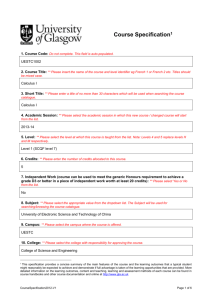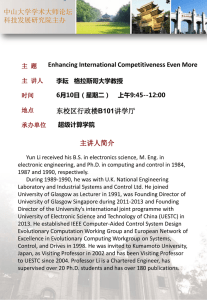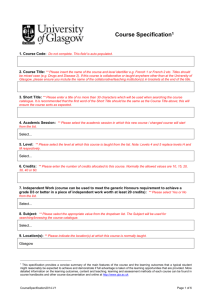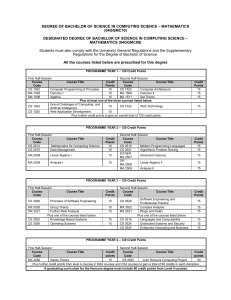Course Specification
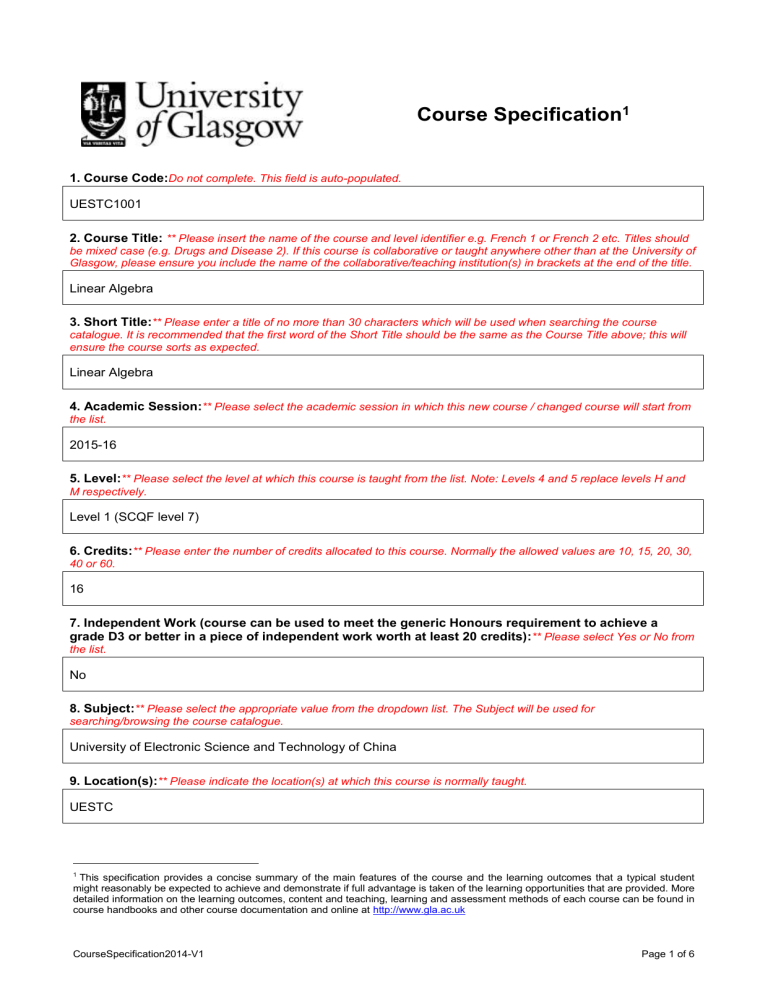
Course Specification
1
1. Course Code: Do not complete. This field is auto-populated.
UESTC1001
2. Course Title: ** Please insert the name of the course and level identifier e.g. French 1 or French 2 etc. Titles should be mixed case (e.g. Drugs and Disease 2). If this course is collaborative or taught anywhere other than at the University of
Glasgow, please ensure you include the name of the collaborative/teaching institution(s) in brackets at the end of the title.
Linear Algebra
3. Short Title: ** Please enter a title of no more than 30 characters which will be used when searching the course catalogue. It is recommended that the first word of the Short Title should be the same as the Course Title above; this will ensure the course sorts as expected.
Linear Algebra
4. Academic Session: ** Please select the academic session in which this new course / changed course will start from the list.
2015-16
5. Level: ** Please select the level at which this course is taught from the list. Note: Levels 4 and 5 replace levels H and
M respectively.
Level 1 (SCQF level 7)
6. Credits: ** Please enter the number of credits allocated to this course. Normally the allowed values are 10, 15, 20, 30,
40 or 60.
16
7. Independent Work (course can be used to meet the generic Honours requirement to achieve a grade D3 or better in a piece of independent work worth at least 20 credits): ** Please select Yes or No from the list.
No
8. Subject: ** Please select the appropriate value from the dropdown list. The Subject will be used for searching/browsing the course catalogue.
University of Electronic Science and Technology of China
9. Location(s): ** Please indicate the location(s) at which this course is normally taught.
UESTC
1 This specification provides a concise summary of the main features of the course and the learning outcomes that a typical student might reasonably be expected to achieve and demonstrate if full advantage is taken of the learning opportunities that are provided. More detailed information on the learning outcomes, content and teaching, learning and assessment methods of each course can be found in course handbooks and other course documentation and online at http://www.gla.ac.uk
CourseSpecification2014-V1 Page 1 of 6
10. College: ** Please select the college with responsibility for approving the course.
College of Science and Engineering
11. Lead School/Institute: ** Please select the school/institute to which the course belongs from the list. If more than one school/institute is involved in the delivery of the course, then please record only the lead school/institute.
Engineering [REG30300000]
11.1 Cost Centre: ** Please select the cost centre relevant to this course.
ENG - Micro and Nanotechnology [30305000]
12. Collaborative: ** Is this course collaborative with any other institutions? Please select either Yes or No from the list.
Yes
13. Teaching Institutions: If the answer to 12 is yes, then please add the names of the other teaching institutions.
University of Glasgow should normally be included.
University of Electronic Science and Technology of China
University of Glasgow
14. Short Description: ** Please enter a short description for this course (no more than two sentences).
This course introduces the fundamental concepts, methods and theories of linear algebra, vector spaces
, quadratic forms and analytical geometry.
15. Requirements of Entry: ** Please enter the Requirements of Entry, both mandatory and recommended, and describe any special arrangements for visiting students. This text will be used to code Enrolment Requirements in
MyCampus. If none, enter "None".
Mandatory Entry Requirements
None
Recommended Entry Requirements
None
16. Co-requisites (courses that must be taken in the same year as this course as a condition of enrolment): Only include other courses which MUST be taken by all students (including visiting students). It is not necessary to list other compulsory courses for a programme that a student would take at the same time.
None
17. Excluded Courses: Please enter courses that are mutually exclusive to this course, i.e. other courses with similar content such that a student cannot gain credit from them along with this course. Examples might include withdrawn courses being replaced by this course. If none, enter "None".
None
18. Associated Programmes: ** Please enter the degree programme(s) for which this is a compulsory course and the main programme(s) for which this is an option, indicating whether the course is compulsory or optional for each programme. If none, enter "None".
CourseSpecification2014-V1 Page 2 of 6
BEng (Hons) Electronics and Electrical Engineering (UESTC) HH5P-2200
BEng (Hons) Electronics and Electrical Engineering with Communications (UESTC)
19. Typically offered: ** Please select from the list when the course is normally taught.
Semester 1
20. Timetable (if known) and length and frequency of teaching sessions: ** If none, enter "None". Detailed information should be given for courses where students must coordinate timetables across several Schools (e.g. Level 1 and Level 2 courses).
Course will be delivered continuously in the traditional manner at UESTC.
21. Minimum Requirement for Award of Credits: ** The minimum requirement for the award of credit applicable to all courses is detailed in the Code of Assessment and included by default below. Please append additional requirements, e.g. attendance.
Students must attend the degree examination and submit at least 75% by weight of the other components of the course’s summative assessment.
22. Available to visiting students: ** Can this course be taken by visiting students? Please select either Yes or No from the list.
No
23. Available to Erasmus students: ** Can this course be taken by Erasmus students? Please select either Yes or
No from the list.
No
24. Taught wholly by distance learning: ** Please select either Yes or No from the list.
No
25. Open Studies Credit Bearing: ** Is this course part of the Open Sudies CertHE accredited programmes?
Please select either Yes or No from the list.
No
26. Represents a work placement or period of study abroad: ** Please select a value from the list.
No
27. Course Aims: ** Please specify the aims of the course. Guidelines are available on the Senate Office website at http://www.gla.ac.uk/services/senateoffice/qae/progdesignapproval/progdesign/ilosguidelines/
This course aims to provide a foundation in linear algebra, vector spaces, analytical geometry and quadratic forms to prepare students for their applications in engineering.
CourseSpecification2014-V1 Page 3 of 6
28. Intended Learning Outcomes of Course: ** Please specify the ILOs of the course. Guidelines are available on the Senate Office website at http://www.gla.ac.uk/services/senateoffice/qae/progdesignapproval/progdesign/ilosguidelines/
By the end of this course students will be able to:
perform linear operations, multiplication,transpose and inverta matrix;
solve linear equations by Gaussian elimination;
compute the determinant of a matrixand use Cramer ’s rule to solve linear equations;
evaluate the rank of a matrix and state its significance;
apply the equations of lines and planes in vector form, to establish the relationship of several lines and that between a line and a plane;
explain the linear combination and the linear dependence of a vector set, including the rank and the concept of a maximum independent set of a vector set;
establish a basis, dimension and coordinates for an n -dimensional vector space;
interpret the solutions of system of linear homogeneous equations in the context of a vector space;
explain the concepts and properties of eigenvalues and eigenvectors, and compute them;
diagonalize a matrix; Inner product, and use Schmidt ’s orthogonalization to construct a normal orthogonal basis;
derive the canonical (standard) form of quadratic forms by invertible transformations and orthogonal transformations;
explain the concept of linear space, includingbases, dimension and coordinates;
29. Learning and Teaching Methods: ** Please indicate the number of formal contact hours for each learning and teaching method listed below as well as the estimated notional learning hours associated with each method. The notional learning hours include the contact hours so should always be equal to or greater than the formal contact hours. Note that
100 notional learning hours correspond to 10 credits (an average student should devote approximately 100 hours in total on a 10-credit course). To ensure automatic totalling, use the Tab key to exit each number field. See HESA guidance on definitions for each method (activity): http://www.hesa.ac.uk/component/option,com_studrec/task,show_file/Itemid,233/mnl,12061/href,Calculations_methods.html
/
Method Formal Contact Hours
Lecture 40.00
Notional Learning Hours
(including formal contact hours)
80.00
Seminar
Tutorial
Project Supervision
Demonstration
0.00
20.00
0.00
0.00
0.00
40.00
0.00
0.00
Practical Classes and Workshops
Supervised time in studio / Workshop
Fieldwork
External Visits
Work Based Learning
Guided Independent Study
Placement
Year Abroad
0.00
0.00
0.00
0.00
0.00
Not Applicable
0.00
0.00
0.00
0.00
0.00
0.00
0.00
40.00
0.00
0.00
TOTAL 60 160
30. Summative Assessment Methods: ** Please enter the total weighting for each category of assessment in the table and describe the assessment in the text box in 29.1 below. Each category can only appear once in the table.
Further breakdown of the categories may be detailed in the text box. It is important that course delivery is consistent with these details and any changes are approved. To ensure automatic totalling, use the Tab key to exit each number field. See HESA guidance on definitions for each method (activity): http://www.hesa.ac.uk/component/option,com_studrec/task,show_file/Itemid,233/mnl,12061/href,Calculations_methods.
html/
CourseSpecification2014-V1 Page 4 of 6
Method
Written Exam
Written Assignment, including Essay
Report
Dissertation
Portfolio
Project Output (Other than dissertation)
%
70%
20%
0%
0%
0%
0%
Oral Assessment & Presentation
Practical Skills Assessment
0%
0%
Set Exercise 10%
TOTAL 100%
30.1 Description of Summative Assessment: ** Describe the assessment below. List the components of assessment, e.g. examinations, in-class tests, essays, lab reports etc. (these may be grouped as a single component) and their relative weightings.
Assessment
Examination 70% - closed book mid term 20%, closed book final exam 50%
Written Assignment 20% - regular homework and attendance
Set Exercise 10% - two quizzes
Reassessment
In accordance with the University’s Code of Assessment reassessments are normally set for all courses which do not contribute to the honours classifications. For non honours courses, students are offered reassessment in all or any of the components of assessment if the satisfactory (threshold) grade for the overall course is not achieved at the first attempt. This is normally grade D3 for undergraduate students, and grade C3 for postgraduate students. Exceptionally it may not be possible to offer reassessment of some coursework items, in which case the mark achieved at the first attempt will be counted towards the final course grade. Any such exceptions are listed below in this box.
30.2 Are reassessment opportunities normally available for all summative assessments in this course: ** The Code of Assessment requires that a candidate achieving a grade below D3 for a non-honours course, or below C3 for a taught postgraduate course, will normally have the opportunity to be reassessed in any of the summative assessments in the course, unless it is not possible to replicate the coursework for the purpose of reassessment (see
Code of Assessment § 16.9). If reassessment is not available in any assessment, please select No below then indicate the assessments for which reassessment is not available. If the course contributes to the final Honours classification, select Not Applicable below, unless the course also contributes to a Masters programme (which are usually expected to offer reassessment opportunities).
Yes
Reassessments are normally available for all courses, except those which contribute to the Honours classification. For non Honours courses, students are offered reassessment in all or any of the components of assessment if the satisfactory (threshold) grade for the overall course is not achieved at the first attempt.
This is normally grade D3 for undergraduate students and grade C3 for postgraduate students.
Exceptionally it may not be possible to offer reassessment of some coursework items, in which case the mark achieved at the first attempt will be counted towards the final course grade. Any such exceptions for this course are described below.
31. Formative Assessment: ** Please describe briefly the assessment methods used to provide feedback to the student but not contributing towards the final grade. If none, enter "None".
None
CourseSpecification2014-V1 Page 5 of 6
32. Grading Basis: ** Please select the appropriate grading basis which will be used for the overall course grade. If not Schedule A or B, you must get permission.
Schedule A
33. Examination Diet: ** Please specify the diet in which formal exams take place. If none, select None.
December
34. Total Exam Duration (Excluding in-class tests): ** Please select the total duration (in minutes) of any endof-course exams from the list below. If there is no exam, enter "0 minutes". Maximum durations for course exams are set out in the Code of Assessment http://www.gla.ac.uk/media/media_205314_en.pdf#page=7&view=fitH,615 and are prescribed by the assessment weight of the exam(s) and the course's level and credit value. The total exam duration may be split across individual exams which must be 60, 90, 120, or (only in the spring exam diet) 180 minutes in length.
120 minutes
34.1 Non-Standard Rationale: If the total duration of the end-of-course exams exceeds the limits specified in 16.14
- 16.21 and Schedule D of the Code of Assessment, http://www.gla.ac.uk/media/media_124297_en.pdf#page=5&view=fitH,285 a case must be made and approval sought from the Senate Office. Please provide rationale below and refer this to the Senate Office.
This is a UESTC delivered course. The examination duration is their standard practice.
35. Additional Relevant Information: Please record any further explanatory information relevant to the course.
This course is part of the Electronic and Electrical Engineering BEng degree delivered at UESTC, China.
The programme draws on the strengths of both the institutions and some courses are delivered wholly by
UESTC. This is a UESTC delivered course Linear Algebra and Space Analytic Geometry I (10071005).
Recommended Textbook and Reference
Linear Algebra and its Applications, 5th edition, David Lay, Steven Lay and Judi McDonald, Pearson, 2015,
9780321982384
Introduction to Linear Algebra, 4th edition, Gilbert Strang, Wellseley Cambridge Press, 2009, 978-
0980232714
Linear Algebra and Space Analytic Geometry , edited by School of Applied Mathematics of UESTC.
Reference book
A Guide to the Simultaneous Study of Linear Algebra and Space Analytic Geometry , edited by School of
Applied Mathematics of UESTC.
36. Intended Student Numbers —Max:
** Please enter the maximum class numbers.
600
37. Intended Student Numbers —Min:
** Please enter the minimum class numbers.
38. Intended Student Numbers —Target:
** Please enter the target class numbers.
200
480
Date of production / revision: 26/05/2015 10:11
CourseSpecification2014-V1 Page 6 of 6
